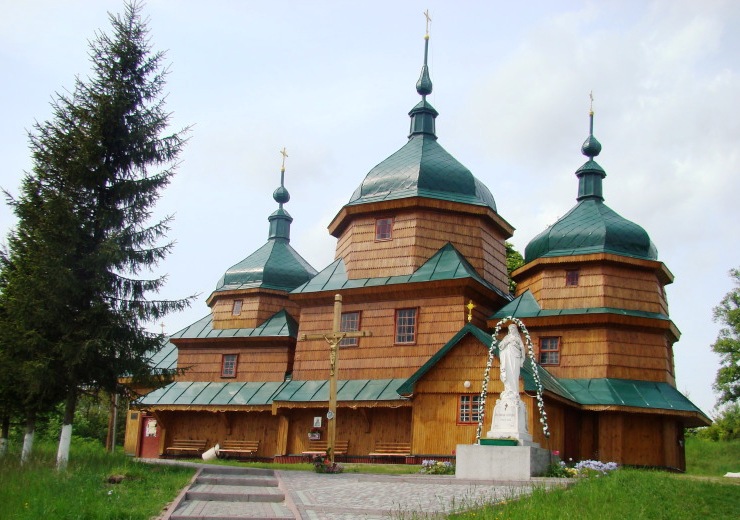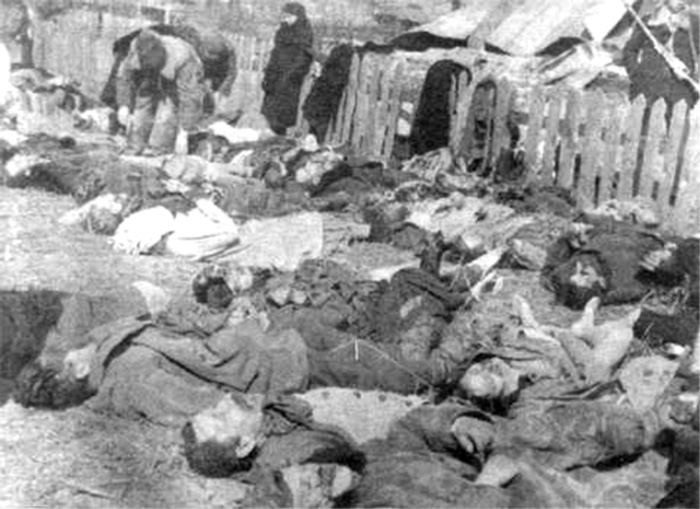|
Borshchovychi
Borshchovychi ( uk, Борщовичі, pl, Barszczowice) is a village in Lviv Raion of Lviv Oblast in Ukraine. It belongs to Novyi Yarychiv settlement hromada, one of the hromadas of Ukraine. First mentioned in 1442 in court documents of the nearby city of Lviv. History According to a 1564 census, the village was inhabited by 20 peasants and 3 innkeepers. Decimated by three successive Tartar raids in the 17th century, by 1665 the population dropped to merely 8 inhabitants. In 1721, the village was bought by Adam Mikołaj Sieniawski who intended to rebuild the village, however a severe famine in 1726 and 1727 forces him to cede the village to the mighty Potocki family in 1729. According to the 1765 census the village was inhabited by 64 families, there are numerous weavers shops, two distilleries, a brewery and an inn. Twenty years later the population of Barszczowice includes 108 peasants and 7 artisans. Following the Partitions of Poland, the village along with the surroundin ... [...More Info...] [...Related Items...] OR: [Wikipedia] [Google] [Baidu] |
Lviv Raion
Lviv Raion ( uk, Львівський район) is a raion (district) of Lviv Oblast, Ukraine. It was created in July 2020 as part of the reform of administrative divisions of Ukraine. The center of the raion is the city of Lviv. Four abolished raions, Horodok, Peremyshliany, Pustomyty, and Zhovkva Raions, as well as Lviv Municipality and parts of Kamianka-Buzka and Zolochiv Raions, were merged into Lviv Raion. Population: . Subdivisions At the time of establishment, the raion consisted of 23 hromadas: * Bibrka urban hromada with the administration in the city of Bibrka, transferred from Peremyshliany Raion; * Davydiv rural hromada with the administration in the selo of Davydiv, transferred from Pustomyty Raion; * Dobrosyn-Maheriv settlement hromada with the administration in the urban-type settlement of Maheriv, transferred from Zhovkva Raion; * Hlyniany urban hromada with the administration in the city of Hlyniany, transferred from Zolochiv Raion; * Horodok urban hromad ... [...More Info...] [...Related Items...] OR: [Wikipedia] [Google] [Baidu] |
Greek Catholic
The term Greek Catholic Church can refer to a number of Eastern Catholic Churches following the Byzantine (Greek) liturgy, considered collectively or individually. The terms Greek Catholic, Greek Catholic church or Byzantine Catholic, Byzantine Catholic Church may refer to: * Individually, any 14 of the 23 Eastern Catholic Churches which use the Byzantine rite, a.k.a. ''Greek Rite'': ** the Albanian Greek Catholic Church ** the Belarusian Greek Catholic Church ** the Bulgarian Greek Catholic Church ** the Greek Catholic Church of Croatia and Serbia ** the Greek Byzantine Catholic Church, in Greece and Turkey ** the Hungarian Greek Catholic Church ** the Italo-Albanian Catholic Church ** the Macedonian Greek Catholic Church ** the Melkite Greek Catholic Church ** the Romanian Greek Catholic Church (officially the ''Romanian Church United with Rome, Greek-Catholic'') ** the Russian Greek Catholic Church ** the Ruthenian Greek Catholic Church ** the Slovak Greek Catholic Church ** ... [...More Info...] [...Related Items...] OR: [Wikipedia] [Google] [Baidu] |
Edmund Cieczkiewicz
Edmund Cieczkiewicz (1872-1958) was a Polish painter and graphic designer. Best known for his Romantic landscapes, he is often dubbed "the last student of Matejko". Born in Barszczowice near Lwów (modern Lviv, then in Austro-Hungarian Galicia), Cieczkiewicz graduated from a gymnasium in Nowy Sącz and in 1887 joined the Kraków Academy of Fine Arts. There he studied painting under the tutelage of Florian Cynk, Władysław Łuszczkiewicz and Leon Wyczółkowski, as well as Jan Matejko and Teodor Axentowicz. He graduated in 1898, along his better-known colleagues: Józef Mehoffer, Stanisław Wyspiański, Xawery Dunikowski and Wojciech Weiss. Although a skilled painter, his personal situation prevented him from devoting his life solely to art. Instead upon graduation he started working for Imperial Royal Austrian State Railways as a railway clerk. He continued to paint though, notably portraits and mountain landscapes of the Beskids and Tatra Mountains, as well as Volhynia and Bia ... [...More Info...] [...Related Items...] OR: [Wikipedia] [Google] [Baidu] |
Pustomyty Raion
Pustomyty Raion ( uk, Пустомитівський район) was a raion in Lviv Oblast in western Ukraine. Its capital (political), administrative center was the city of Pustomyty. The raion was abolished on 18 July 2020 as part of the administrative reform of Ukraine, which reduced the number of raions of Lviv Oblast to seven. The area of Pustomyty Raion was merged into Lviv Raion. The last estimate of the raion population was . It was established in 1959. At the time of disestablishment, the raion consisted of nine hromadas: * Davydiv rural hromada with the administration in the Village#Ukraine, selo of Davydiv; * Murovane rural hromada with the administration in the selo of Murovane, Lviv Raion, Lviv Oblast, Murovane; * Obroshyne rural hromada with the administration in the selo of Obroshyne; * Pidberiztsi rural hromada with the administration in the selo of Pidberiztsi, Lviv Oblast, Pidberiztsi; * Pustomyty urban hromada with the administration in Pustomyty; * Shchyrets ... [...More Info...] [...Related Items...] OR: [Wikipedia] [Google] [Baidu] |
Ukrainian SSR
The Ukrainian Soviet Socialist Republic ( uk, Украї́нська Радя́нська Соціалісти́чна Респу́бліка, ; russian: Украи́нская Сове́тская Социалисти́ческая Респу́блика, group=note), abbreviated as the Ukrainian SSR, UkrSSR, or UkSSR, and also known as Soviet Ukraine, was one of the constituent republics of the Soviet Union from 1922 until 1991. In the anthem of the Ukrainian SSR, it was referred to simply as ''Ukraine''. Under the Soviet one-party model, the Ukrainian SSR was governed by the Communist Party of the Soviet Union through its republican branch: the Communist Party of Ukraine. The first iterations of the Ukrainian SSR were established during the Russian Revolution, particularly after the Bolshevik Revolution. The outbreak of the Ukrainian–Soviet War in the former Russian Empire saw the Bolsheviks defeat the independent Ukrainian People's Republic, after which they fou ... [...More Info...] [...Related Items...] OR: [Wikipedia] [Google] [Baidu] |
Soviet Union
The Soviet Union,. officially the Union of Soviet Socialist Republics. (USSR),. was a transcontinental country that spanned much of Eurasia from 1922 to 1991. A flagship communist state, it was nominally a federal union of fifteen national republics; in practice, both its government and its economy were highly centralized until its final years. It was a one-party state governed by the Communist Party of the Soviet Union, with the city of Moscow serving as its capital as well as that of its largest and most populous republic: the Russian SFSR. Other major cities included Leningrad (Russian SFSR), Kiev (Ukrainian SSR), Minsk ( Byelorussian SSR), Tashkent (Uzbek SSR), Alma-Ata (Kazakh SSR), and Novosibirsk (Russian SFSR). It was the largest country in the world, covering over and spanning eleven time zones. The country's roots lay in the October Revolution of 1917, when the Bolsheviks, under the leadership of Vladimir Lenin, overthrew the Russian Provisional Government ... [...More Info...] [...Related Items...] OR: [Wikipedia] [Google] [Baidu] |
Massacres Of Poles In Volhynia And Eastern Galicia
The massacres of Poles in Volhynia and Eastern Galicia ( pl, rzeź wołyńska, lit=Volhynian slaughter; uk, Волинська трагедія, lit=Volyn tragedy, translit=Volynska trahediia), were carried out in German-occupied Poland by the Ukrainian Insurgent Army, or the UPA, with the support of parts of the local Ukrainian population against the Polish minority in Volhynia, Eastern Galicia, parts of Polesia and Lublin region from 1943 to 1945. The peak of the massacres took place in July and August 1943. Most of the victims were women and children. Many of the Polish victims regardless of age or gender were tortured before being killed; some of the methods included rape, dismemberment or immolation, among others. The UPA's actions resulted in between 50,000 and 100,000 deaths. According to Timothy Snyder, the ethnic cleansing was a Ukrainian attempt to prevent the post-war Polish state from asserting its sovereignty over Ukrainian-majority areas that had been part of th ... [...More Info...] [...Related Items...] OR: [Wikipedia] [Google] [Baidu] |
Ukrainian Insurgent Army
The Ukrainian Insurgent Army ( uk, Українська повстанська армія, УПА, translit=Ukrayins'ka povstans'ka armiia, abbreviated UPA) was a Ukrainian nationalist paramilitary and later partisan formation. During World War II, it was engaged in guerrilla warfare against the Soviet Union, the Polish Underground State, Communist Poland, and Nazi Germany. It was established by the Organization of Ukrainian Nationalists. The insurgent army arose out of separate militant formations of the Organization of Ukrainian Nationalists—Bandera faction (the OUN-B), other militant national-patriotic formations, some former defectors of the Ukrainian Auxiliary Police, mobilization of local populations and others.Vedeneyev, D. Military Field Gendarmerie – special body of the Ukrainian Insurgent Army'. "Voyenna Istoriya" magazine. 2002. The political leadership of the army belonged to the OUN-B. It was the primary perpetrator of the ethnic cleansing of Poles in Volhy ... [...More Info...] [...Related Items...] OR: [Wikipedia] [Google] [Baidu] |
Operation Barbarossa
Operation Barbarossa (german: link=no, Unternehmen Barbarossa; ) was the invasion of the Soviet Union by Nazi Germany and many of its Axis allies, starting on Sunday, 22 June 1941, during the Second World War. The operation, code-named after Frederick Barbarossa ("red beard"), a 12th-century Holy Roman emperor and German king, put into action Nazi Germany's ideological goal of conquering the western Soviet Union to repopulate it with Germans. The German aimed to use some of the conquered people as forced labour for the Axis war effort while acquiring the oil reserves of the Caucasus as well as the agricultural resources of various Soviet territories. Their ultimate goal was to create more (living space) for Germany, and the eventual extermination of the indigenous Slavic peoples by mass deportation to Siberia, Germanisation, enslavement, and genocide. In the two years leading up to the invasion, Nazi Germany and the Soviet Union signed political and economic pacts for st ... [...More Info...] [...Related Items...] OR: [Wikipedia] [Google] [Baidu] |
World War II
World War II or the Second World War, often abbreviated as WWII or WW2, was a world war that lasted from 1939 to 1945. It involved the vast majority of the world's countries—including all of the great powers—forming two opposing military alliances: the Allies and the Axis powers. World War II was a total war that directly involved more than 100 million personnel from more than 30 countries. The major participants in the war threw their entire economic, industrial, and scientific capabilities behind the war effort, blurring the distinction between civilian and military resources. Aircraft played a major role in the conflict, enabling the strategic bombing of population centres and deploying the only two nuclear weapons ever used in war. World War II was by far the deadliest conflict in human history; it resulted in 70 to 85 million fatalities, mostly among civilians. Tens of millions died due to genocides (including the Holocaust), starvation, ma ... [...More Info...] [...Related Items...] OR: [Wikipedia] [Google] [Baidu] |


.jpg)
